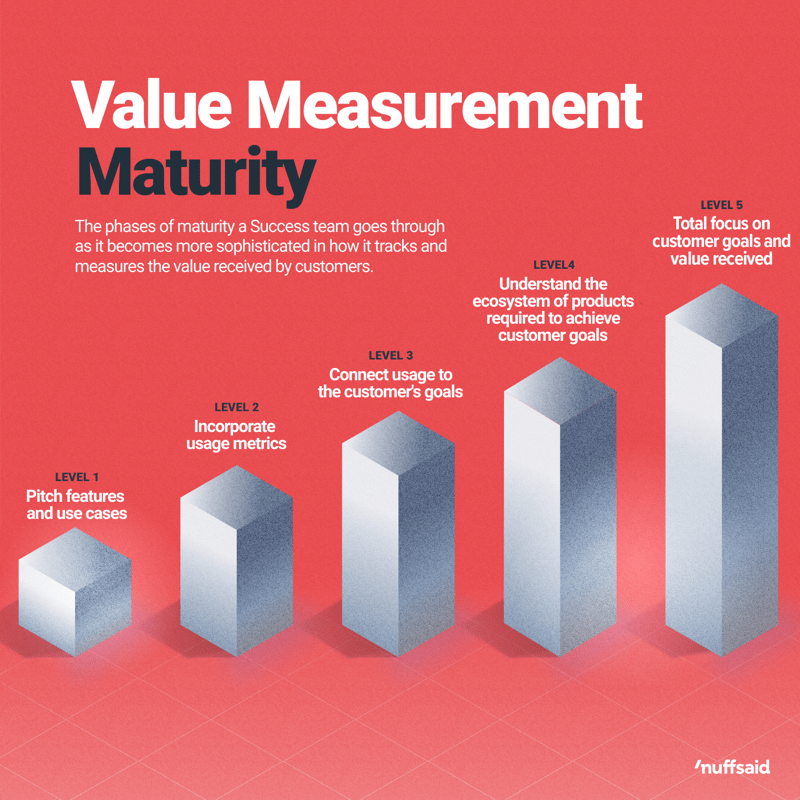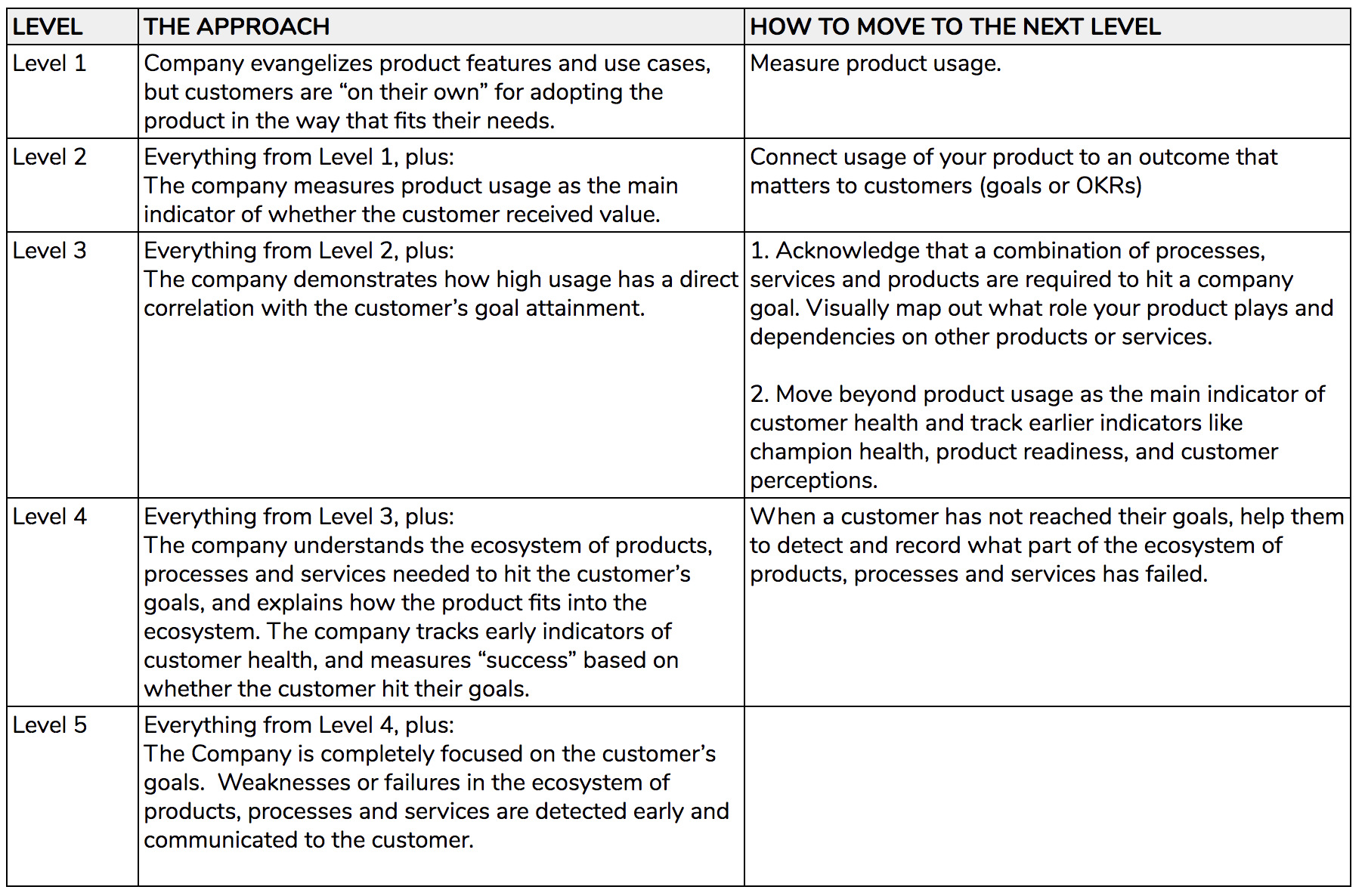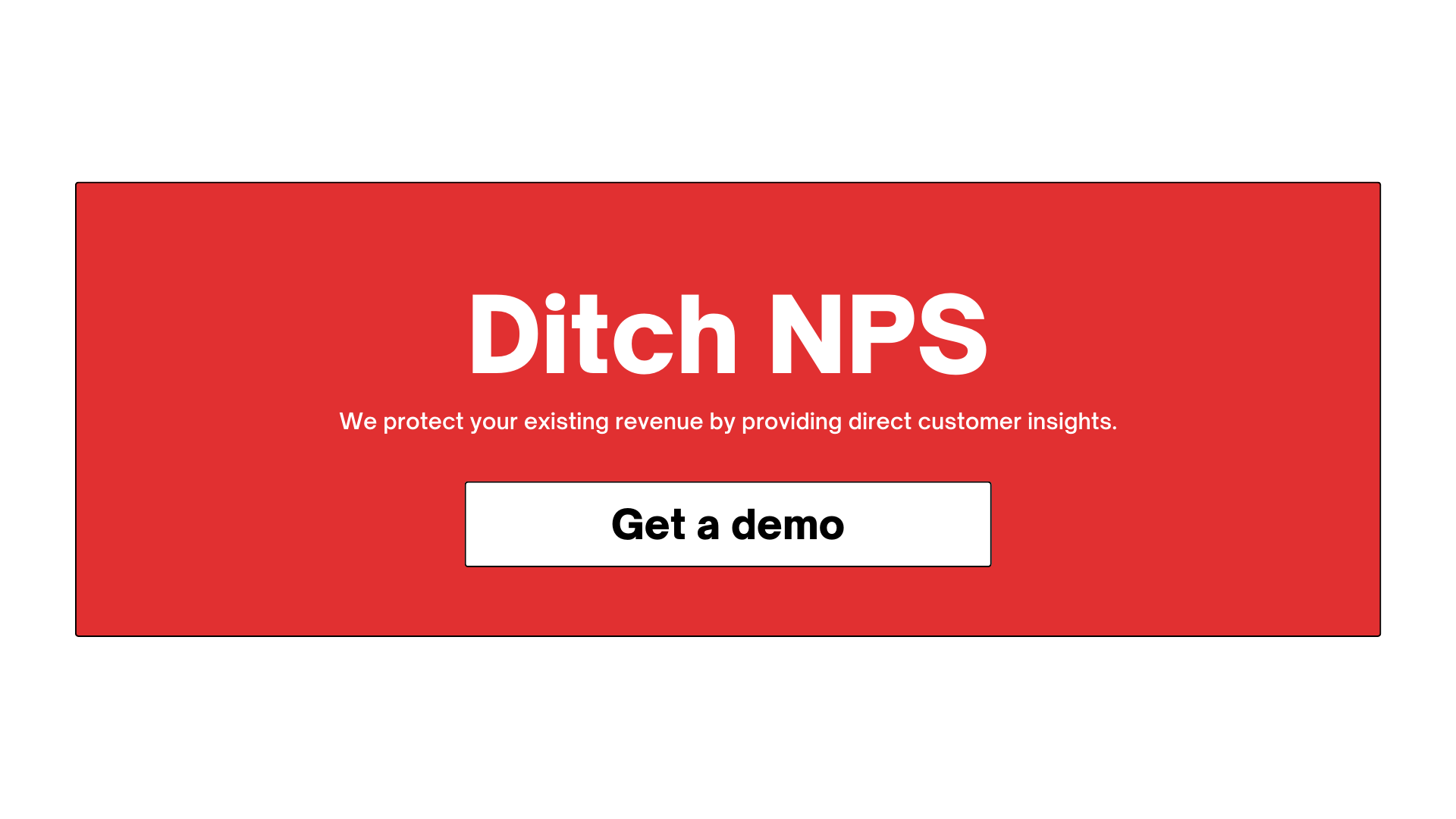Our customers don’t come to us because they want a “product.” They want a solution to their problem. But many companies don’t try to measure whether or not the customer problem has been solved, and the ones that do typically focus on how frequently the product is used (an internal metric that has nothing to do with the customer’s success).
Take an example of a fictional fitness watch company, FitWatchCo, which plans to sell more watches; the consumer wants to lose weight. FitWatchCo focuses their messaging on features—heart rate monitoring, step counting, and altitude tracking—expecting the customer to figure out the best use cases to solve their problem. Then, FitWatchCo measures the number of times their fitness watch is used per day, without any consideration for whether or not the customer lost weight. FitWatchCo is delighted to see frequent usage and assumes the customer is happy. Next month, when the customer hasn’t lost weight, the customer sells their fitness watch.
If we’re going to keep our department named “Customer Success”, it’s important to iterate and improve on our understanding of the value received by our customers. The framework below provides a quick summary of the journey you’re likely to follow.

Level 1: Pitch features and use cases
Many software companies are product-obsessed. You can see it right away on their websites—they’re marketing attractive features and benefits. There’s no language around how customers can use the product to reach their specific goals.
It’s easy to think about Level 1 using the fitness watch example. The company is essentially saying, “here’s the product!” And the onus is on the customer to figure out how to use it to achieve their goals.
Now, some might argue that B2C companies have to talk about their product features because there are unlimited use cases for consumers. But great B2C product presenters, like Steve Jobs, always paint the picture of how your life will be changed and improved. The focus isn’t on selling the product, it’s on selling life with the product.
In B2B, Level 1 looks like this: the Success team solely focuses their time with customers on explaining features and use cases. There isn’t a tie to the customer’s goals. “Here’s the product, go use it.” If the customer doesn’t use the product, that’s on them.
The way Success teams can move to Level 2 is to track usage metrics to evaluate whether customers are receiving value.
Level 2: Incorporate usage metrics
Here, the Success team still focuses on pitching features and use cases to customers, but is also leveraging usage metrics to evaluate whether customers are getting value out of the product.
Since low adoption is one of the top reasons for churn, companies begin tracking usage data as a feedback loop for understanding how customers are doing. This behavior is a step in the right direction and can help companies identify customers who aren’t using the product, aren’t using enough features, or don’t have enough total active users.
What Level 2 is missing is connecting usage to an outcome that matters to customers. The way Success teams move to Level 3 is by identifying the customer’s goals and then demonstrating how using the product frequently will help the customer achieve their specific goals. It’s moving from saying “Here’s how our customers should use the product,” to “Here’s how you should use the product and why using the product in this way will help you reach your goals.”
Level 3: Connect usage to the customer's goals
The next level of maturity is for Success teams to align usage of the product to the customer’s goals. Instead of focusing on features and use cases, Success teams anticipate 3-4 high-level objectives that customers will have when buying their product and create playbooks for helping customers achieve those goals with their product. ← The most mature companies today are at this level.
So if a customer has a goal of increasing revenue by 3%, the CSM would follow a playbook that shows the customer how to use the product to achieve that goal.
Here’s what’s missing in Level 3, and how Success teams here can move to Level 4:
- Companies acknowledge that their product alone won’t help a customer reach their goals—instead, a combination of processes, services, and products are required. They can then map out what role their product plays and the dependencies on other products or services.
- Success teams will also begin to use more sophisticated metrics and triggers for understanding whether customers are getting value out of the product.
Tracking product usage is a good step towards understanding how customers are experiencing the product, but it’s a company-centric metric. The amount of usage is not highly correlated to the value received by the customer. So to move to Level 4, companies have to invest in other approaches to better understand the value received.
Level 4: Understand the ecosystem of products required to achieve customer goals
There are no products that own the entire ecosystem of people, tools, and services required to hit a company’s objective. If your customer wants to increase revenue by 3%, your product is only one part of that story. The key to moving to level 4 is understanding where the product fits in that ecosystem and then being able to coach customers to leverage all the moving parts required to hit the customer’s goal.
A company that sells marketing automation might have a customer say, “We have a goal of 200 demo requests per month.” And a mature marketing automation company would respond, “Great, we’re one part of that. We’re going to help you with this, and you’re also going to need these other tools and services to hit that goal.”
When companies understand how the ecosystem plays together, they can pinpoint risk and systematically act on it. If your company does it’s part, but your customer doesn’t successfully adopt another tool, you can see where the risk is coming from and help the customer know where to allocate their energy.
Success teams in Level 4 have also moved beyond relying on product usage as the main indicator that the customer is receiving value, and have begun to track earlier indicators of customer health like:
- Whether the product has been embedded in the customer’s processes,
- Whether there are enough champions and if they have the right level of influence within the organization,
- How the customer perceives the “pain” of the problem solved by the product (is it severe or a nice to have?), and
- Whether they feel the product is “complete” or if it needs features or fixes for them to get what they want out of the product.
Here’s what’s missing in Level 4. Level 4 assumes the question of whether the customer “received value” is binary: either the customer received value, or they didn’t. But in reality that’s rarely the case. Customers can realize some value from a product, but not get everything they were expecting. Companies at Level 5 are able to detect and record when customers have received partial value.
Level 5: Total focus on customer goals and value received
Level 5 is where the Customer Success team not only understands the customer’s goal, the ecosystem of products required to meet that goal, and is tracking early indicators of customer health, but they’re also able to record and detect whether the customer received partial value.
At this level, the company has recorded each goal that the customer wants to accomplish. The company visualizes the products, services, and processes needed to accomplish each goal. Each player in the ecosystem is assigned metrics to indicate if they’re meeting, exceeding, or below expectations.
Since a failure anywhere in the ecosystem could lead to the company failing to hit its goals, it’s critical that the company is able to identify weaknesses early. Periodically (monthly or quarterly), the entire ecosystem is reviewed and evaluated by the company and the customer.
Returning to the example at the beginning of this article, let’s examine how FitWatchCo would perform in a Level 5 environment.
First, FitWatchCo would acknowledge that the customer’s goal is to lose weight. FitWatchCo would identify that in order to lose weight, the customer will need an ecosystem of products, processes, and services to accomplish the goal:
- A fitness watch
- A fitness coach
- A defined diet
- A fitness app
Each player will receive success metrics:
- Fitness watch measures 10,000 steps per day and 8 hours of sleep
- Fitness coach delivers exercise program on Sunday every week
- Diet plan includes meal choices, calorie counts and macro counts
- Customer enters daily weight, diet, and exercise into fitness app and shares with trainer
FitWatchCo or the trainer meet with the customer on a monthly or quarterly basis to review progress towards goals and identify weaknesses early. Each player in the ecosystem only ‘wins’ if the customer actually loses weight. Otherwise, the customer gives up and everyone experiences a “churn” event.
When we reach this level of maturity, we’ve finally earned “Customer Success” as the title of our department.
Summary
Here’s an overview of each phase of maturity and move to the next level.



